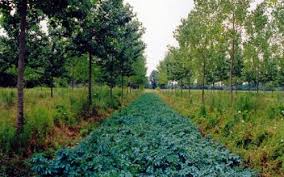Source: pft.tas.gov.au
Published: March 2, 2017
Agroforestry Program
Trees grown on farmland provide a range of benefits and values to landowners and the community. Well planned tree plantings can increase farm profits by improving crop and animal growth and providing additional income from wood sales. Trees on farms also provide environmental and social benefits that often extend beyond farm boundaries. Private Forests Tasmania, in collaboration with CSIRO and the University of Tasmania, leads an Agroforestry program that will demonstrate the benefits of trees in Tasmanian agricultural landscapes. It is hoped that this will inspire private landowners to realise the benefits of Agroforestry.
Tasmania has an ideal climate and the skills base needed to sustainably grow trees commercially on farms. Trees can contribute to the traditional sawn timber and pulp wood markets, however the range of products derived from wood is now proliferating and many experts are predicting that the world is entering the ‘bio-economy’ era, with wood one of the more important feedstocks.
As well as engineered wood, a lot of the products and services we now get from fossil fuel are likely to be derived from renewable sources such as wood in the future.
We must continue to look ahead. Trees are a long rotation crop and what we plant today is for an industry 15 to 30 years out from now. Forestry can and should, therefore, remain an important part of Tasmania’s economy and the planting of commercial tree species on farms, carefully and sensitively integrated into the farms overall management plan (agroforestry), is one of the few remaining ways to significantly increase the State’s commercial forest resource.
As well as improving farm income through improved farm output and revenues for harvested wood, trees improve aesthetics and provide environmental outcomes. The shelter provided by trees provides significant benefits for livestock and crops. Unfortunately, the planting of commercial woodlots and shelterbelts by farmers is not currently a universal practice in Tasmania, notwithstanding these benefits. Apart from a small and passionate group of farm forestry devotees, it is not a well-established ‘matter of course’ activity for Tasmanian farmers to plant shelter belts and blocks – in fact, many fail to recognise the opportunity trees represent mainly through lacking access to credible information and experience of the benefits.
Private Forests Tasmania now has a focus on clearly demonstrating the benefits and providing solid science based information to encourage more farmers to plant commercial trees in shelter belts and small blocks to add value to their farming business while creating future resource for industry.
The benefits of Agroforestry are well documented elsewhere.
For more information on the best way to introduce trees into farmland and on the benefits of Agroforestry please contact PFT and/or read:
– Abel, N et al (1997) Design Principles for Farm Forestry. RIRDC. Barton, ACT 102 pages
http://www.agroforestry.net.au/main.asp?_=publicationsAckroyd, T (2014) Trees for farm productivity. RMCG. Penguin.
– Trees for Farm productivity. Case Study 2014. Cygney, Huon Valley, Tasmania
http://www.rmcg.com.au/media/Projects/CC/Final%20Trees%20on%20Farms%20-%20CGWhite%20140514_reduced.pdf
– Anon (2012) Benefits of trees for farm productivity. Project Platypus, Victoria
http://www.platypus.org.au/docs/fact_sheets/Benefits%20of%20Trees.pdf
– Anon (2015) The economic benefits of native shelter. Basalt to Bay Landcare Network, Victoria
http://www.forestry.org.au/ckeditor/ckfinder/userfiles/files/EBONS%20Report%20Issue%203%202015_30%20July%20Newsletter.pdf
– Bird, PR (2003) Sustainable systems of dairy production – a review of water quality, biodiversity, soil salinity/acidity, farm forestry, shade/shelter and productivity issues, and the likely impact on these of revegetation of dairy farms. DPI Victoria, Hamilton. 258 pages
http://www.westvicdairy.com.au/Portals/0/content/publications/industry-reports/natural-resource-management/Sustainable-Systems-of-Dairy-Production.pdf
– Cleugh, H (2003) Trees for shelter – a guide to using windbreaks on Australian farms. RIRDC. Barton, ACT 70 pages. An abbreviated version is available at http://www.crec.ifas.ufl.edu/extension/windbreaks/pdf/AustralianWindbreaks.pdf
Links to other PFT info on Agro Forestry – http://www.pft.tas.gov.au/publications/agroforestry
An additional source of a wealth of information is the Farm Forest Line http://www.farmforestline.com.au/pages/2.2_supporting.html
Farm Forest Line is a free information service managed by Australian Forest Growers in association with Melbourne University School of Resource Management and Energy Strategies.
Farm Forest Line provides reliable information and advice about farm forestry practice, opportunities and developments:
– Hundreds of pages of information on a wide range of topics
– News on farm forestry events and announcements,
– Links to an extensive range of farm forestry organisations and resources,
– Search our catalogue of farm forestry information,
– Professional and prompt email, fax back and mail out advice.
In particular, the pages Supporting Agricultural Production http://www.farmforestline.com.au/pages/2.2_supporting.html, and links, are especially relevant.

